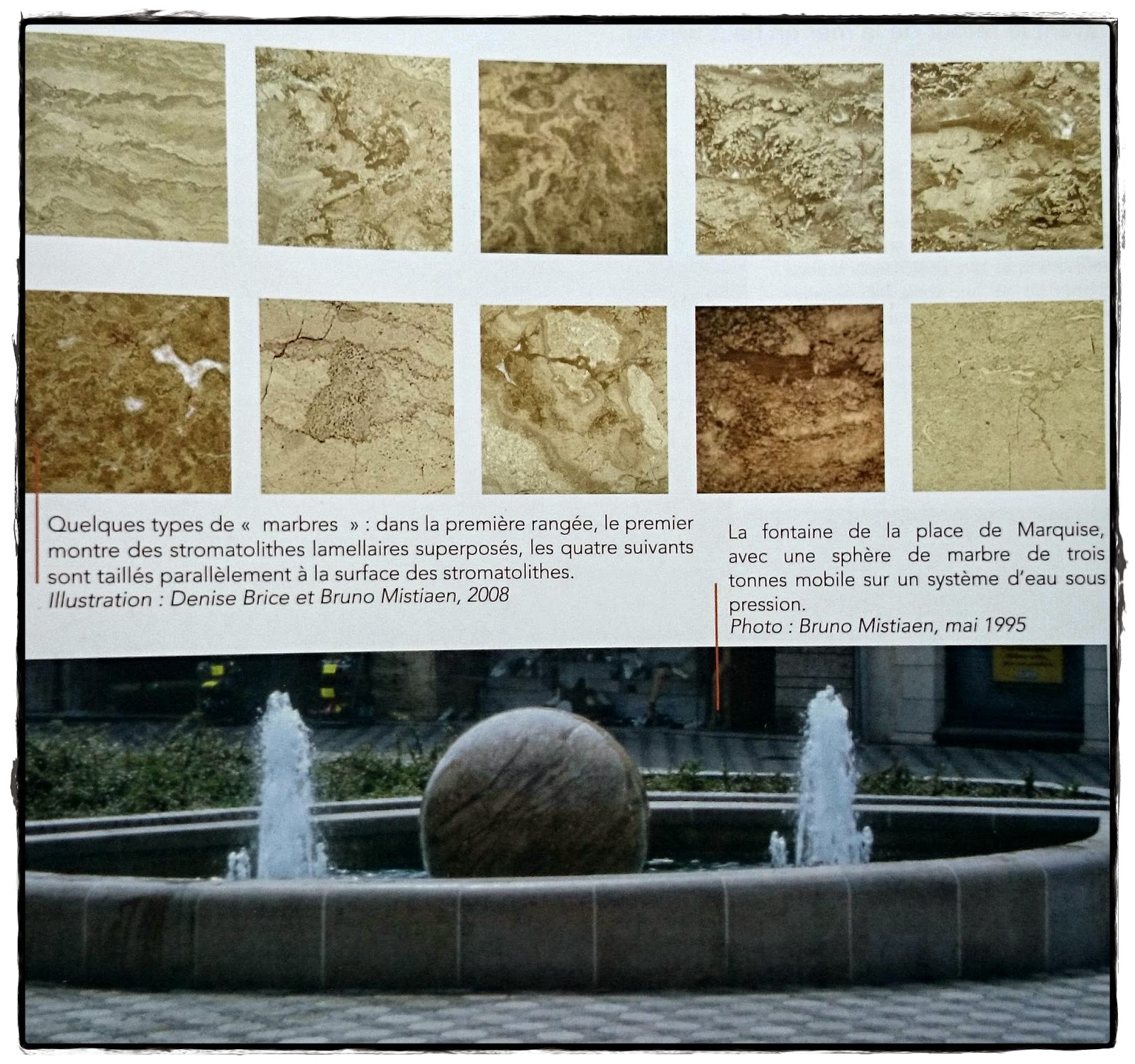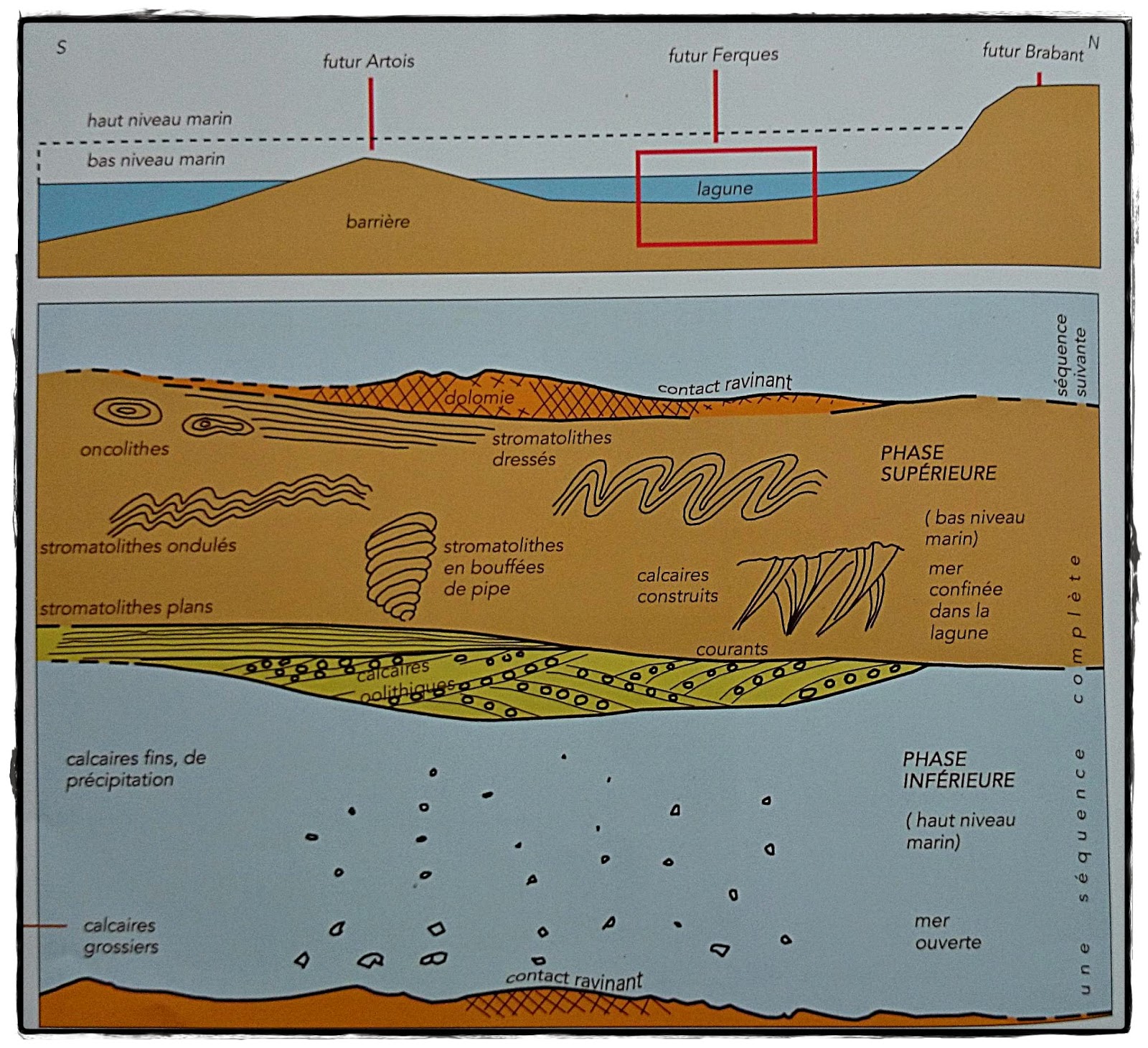
 Francais
Francais
La colonne de la grande armée à Boulogne-sur-Mer supportant la statue de Napoléon a été réalisée entre 1804 et 1825 en "marbre" provenant de cette carrière et c'est qui a donné son nom.
Au cœur de la structure anticlinale du Boulonnais, les érosions au cours Tertiaire et du Quaternaire on enlevé des couches de sables tertiaire, des craies, marnes et argiles crétacées, de grès, calcaires et marnes jurassiques pour laisser affleurer les terrains primaires plissés dans ce que l'on appelle le "massif de Ferques". Les terrains de ce massif aux caractéristiques très variées ont été reconnus et exploités depuis des siècles. Ces calcaires ont été particulièrement utilisés pour leur résistance.
Exploités dès le XVIIIe siècle, ils ont été exportés et utilisés comme pierre d'ornement dans le monde entier : la Casa Del Aviatore à Rome, la gare de Tokyo au Japon, la gare Montparnasse à Paris, sans oublier la fontaine de la Place de Marquise et la colonne de la Grande Armée à Boulogne-sur-Mer.


Phase géologique:
En haut niveau marin, la lagune est ouverte sur l'océan et les sédiments qui s'y déposent sont de boues calcaires de précipitation, grossières puis de plus en plus fines avec quelques rares fossiles (algues, petit coraux...) qui se terminent par des calcaires oolithiques. En bas niveau, la barrière isole la lagune qui est alors confinée. Là, peuvent se développer des récifs coralliens puis des nombreuses formes stromatolithes (calcaires à laminations d'origine bactérienne) : en tapis, ondulés, en bouffées de pipe ou encore en nodules d'oncolithes. Dans la lagune en voie d'assèchement les éléments chimiques présents dans les eaux se concentrent et peuvent donner des dolomies voire des sels chlorés. Le retour d'un haut niveau engendre ensuite le début d'un nouveau cycle. Ce processus s'est répété au moins une centaine de fois dans cette lagune, mais pas toujours de manière complète, selon le niveau d'assèchement avant le retour de la mer en haut niveau.

Marbres primitifs:
Le marbre primitif est issu de terrains calcaires qui se sont formés à une période où il n’existait aucune vie marine. Le dépôt de cette matière calcaire, sur des roches anciennes, ne s’est pas fait de manière égale, car des circonstances particulières des attractions plus ou moins fortes déterminèrent la formation de quelques couches plus épaisses que les autres, et moins mêlées de feuillets schisteux. Au cours du cycle hercynien (-416 à –251 millions d’années), la couche inférieure de roches ancienne (granite) souleva les couches de sédiments primaires les plus épaisses et encore semi-fluides, qui retombèrent sur elles-mêmes et qui formèrent, aux pieds des grandes chaînes, des cordons de collines calcaires mêlées de schistes et de serpentines. Des bouleversements physico-chimiques transformèrent cette roche sédimentaire des collines en roche métamorphique, qui donna naissance aux marbres primitifs, grenus, sensiblement cristallisés et généralement d’une seule couleur, blanc, gris, rouge ou noir.
Ce sont ces grandes masses de marbres homogènes qui fournissent les marbres statuaires, tels que ceux de Paros et de Carrare ; qui ne sont jamais dans des zones très élevées.
Ces couches qui se sont trouvées interposées entre les feuillets schisteux ou même avec des couches de serpentine, donnent des marbres nommés Cipolins, qui présentent de longues veines parallèles et ondulées. Ces marbres se trouvent dans le voisinage des sommets des montagnes.
Bien que ces marbres ne contiennent jamais de coquilles ni d’organismes marins, certains renferment des grenats, des cristaux de fer octaèdre et même des pyrites. Ce fer octaèdre, attirable à l’aimant, se rencontre quelques fois dans les plus beaux marbres blancs de Carrare, sous forme de taches et de veines noirâtres. Les brèches calcaires sont aussi des marbres primitifs.
Marbres secondaires:
Ces derniers appartiennent à divers âges. Il y en a de très anciens ; ils appartiennent aux terrains que les naturalistes désignent par le mot transition.
- Les marbres secondaires, qui ne contiennent pas ou très peu de corps marins, ont été déposés dans les océans alors qu’il n’existait aucun être organisé.
- Les marbres secondaires coquilliers, contiennent quelques débris de corps marins, par exemple la brèche tarentaise et le marbre Campan qui contient des térébratules.
- Les lumachelles, qui sont la dernière formation, se trouvent presque totalement composés de coquilles, de madrépores et autres corps marins.
Les marbres secondaires sont le plus souvent disposés en couches régulières, plus ou moins en position horizontale. Leur tissu est ordinairement compact, leur cassure lisse, terne et presque conchoïdale. Ce sont les plus beaux marbres qui reçoivent un poli proportionnel à leur dureté et qui offrent des couleurs plus ou moins vives, plus ou moins variées dues à des oxydes de fer.
Rappel concernant les « Earthcaches »: Il n'y a pas de conteneur à rechercher ni de logbook à renseigner. Il suffit de se rendre sur les lieux et d'exécuter les requêtes du propriétaire (envoi d'un mail pour validation de TOUTES les questions) BON EARTHCACHING!
Pour valider votre visite:
1-. Quel est le point le plus haut et le plus bas de la paroi de la carrière que vous avez en face. (Panneau d’information)
2-. Terminez la frase (panneau d’information) : L’exportation représente près de ….% des ventes.
3-. A votre droite il y a 5 grands blocs de marbre de cette carrière, avec l'information proportioné sur le listing de la cache, nomez si sont Marbres primaires ou Secondaires.
 English
English
The column of the Grand Army at Boulogne-sur-Mer supporting the statue of Napoleon was created between 1804 and 1825 with "marble" from this quarry, which explains his name.
At the heart of the Anticline structure of Boulogne, erosions during the Tertiary and the Quaternary removed layers of tertiary sands, chalk, marl and clay cretaceous sandstone, Jurassic limestone and marl to give place to the primary land pleated on what is called the "massif of Ferques". The grounds of this massif with very different characteristics have been recognized and exploited for centuries. These limestones were particularly used for their resistance.
Exploited from the eighteenth century, they were exported and used as an ornamental stone in the whole world: Casa Del Aviatore in Rome, Tokyo Station in Japan, the Montparnasse station in Paris, not to mention the fountain in the Place de Marquise and the column of the Grande Armée in Boulogne-sur-Mer.


Geological phase:
Above sea level, the lagoon is open to the ocean and sediments that are deposited are limestone sludge precipitation, coarse and then finer with few fossils (algae, small corals ...) which end in oolitic limestones. In low level, the barrier isolates the lagoon which is then confined. There can grow coral reefs and many forms of stromatolites (limestone bacterial laminations): carpet, corrugated or in nodules oncolites. In the lagoon, which is in a drying process, the chemical elements present in the water are concentrated and can give dolomites or even chloride salts. The return to a higher level creates the beginning of a new cycle. This process has been repeated at least a hundred times in the lagoon, but never by complete, depending on the level of drying before the return of the sea at the top level.

Primitive marbles:
The original marble comes from limestone soils that formed at a time when there were no marine life. The deposition of this limestone material on ancient rocks, wasn't equally, because of the particular circumstances stenghts of attraction determined the formation of some thicker layers than others, and less mixed with shale layers. During the Hercynian cycle (-416 to -251 milion years), the lower layer of ancient rocks (granite) raised the thicker layers of primary sediments, which fell over themselves and formed the foot of the big chains, cords limestone hills interspersed with shale and serpentine. Physicochemical changes transformed this sedimentary rock hills in metamorphic rock, which gave birth to the marble primitive, grainy, crystallized substantially and usually a single color, white, gray, red or black.
These are the great masses of homogeneous marble statuary marble providing, such as Paros and Carrare; which are never very high areas.
These layers were found interposed between the shale layers or even with layers of serpentine, give marbles appointed marbles, which have long parallel veins and wavy. These marbles are in the vicinity of the mountain peaks.
Although these marbles never contain shells of marine organisms, some contain garnets, crystals and even octahedral iron pyrites. This octahedron iron, attracted by the magnet, occurs a few times in the most beautiful white Carrare marble, as spots and blackish veins. The limestone breccias are also primitive marble.
Secondary marbles:
These marbles belong to various ages. There are very old; they belong to the land that naturalists call transition.
- Secondary marbles, which doesn't contain (or contain very few) marine corps, have been deposited in the ocean when there was none organisez being.
- The shell side marbles contain some debris Marine Corps, for example Tarentaise and Campan marble breccia containing terebratula.
- The lumachelles, which are the latest formation, are almost entirely composed of shells, stony corals and other marine bodies.
Secondary marbles are generally arranged in regular layers, more or less horizontal. Their fabric is usually compact, their smooth, dull and almost conchoidal fracture. These are the most beautiful marbles that are proportional to their hardness and polished offering colors more or less vivid, more or less varied due to iron oxides.
Reminder on "Earthcaches": There is no container or logbook on the given coordinates. Just visit the site and answer the questions by e-mail. There is no need to wait for my reply, feel free to log immediately after. If the answers are incorrect, I will let you know. HAPPY EARTHCACHING!
To validate your visit:
1 -. What are the highest and the lowest points of the wall of the quarry you have in front of you. (Information board)
2 -. Complete the sentence (information board): Exports represent almost ....% of sales.
3-. At your right there are five large blocks of marble from the quarry, with information given on the listing of the cache, say if they are primary or secondary marbles.
EarthCaches are cool, just think and cache them!

